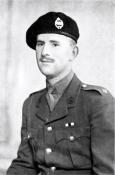
|
The King's School Canterbury |
Roll of Honour |
| Lieutenant Arthur Dunstan Beverley HARRE (102327) MC | |
|
7 Troop, B Squadron, 47th (Oldham) Royal Tank Regiment, Royal Armoured Corps Date of birth: 19th May 1913 Date of death: 27th October 1942 Killed in action aged 29 Buried at El Alamein War Cemetery Plot XVIII Row G Grave 9 |

|
| He was born at St Dunstan's Vicarage, Benoni, Transvaal in South Africa on the 19th of May 1913 the only child of the Reverend Alfred Thomas Harre AKC, the Vicar of Benoni, and Louise, and the step son of Marjorie Charlotte Vivian (nee Harris) of 119 Birdhurst Road, Croydon in Surrey. He was educated at the Junior King's School from September 1920 to March 1925 and at St John's School Leatherhead where he was in North House from 1925 to 1930. He was a member of the Photographic Society and was in the Special Form. He was confirmed by the Bishop of Guildford in St John's School Chapel on the 25th of November 1927. On leaving school he went to work for Coutts Bank. In 1937 he joined the Westminster Dragoons, part of the Territorial Army, and he was mobilised for on the outbreak of war. He was commissioned as a 2nd Lieutenant in the Royal Tank Regiment on the 19th of November 1939. In January 1940 he was appointed to the staff of General Bernard Law Montgomery (OKS) at 3rd Infantry Division as a Motor Control Liaison Officer. He took part in operations in Belgium and escaped from Dunkirk by swimming from the beach to a boat. For his actions during the campaign he was awarded the Military Cross on the 11th of July 1940. On his return to England he served firstly as an Aide De Camp and later as a Staff Captain to General Montgomery. He was promoted to Lieutenant on the 28th of January 1941. He requested a transfer to a more active role and obtained permission to return to a front line tank unit. As a result he was posted to the Middle East with the 47th Royal Tank Regiment, part of 10th Armoured Division in May 1942 where he was given command of 7 Troop in B Squadron. During the Battle of El Alamein he was involved in the Miteiriya operations and on Tuesday the 27th of October 1942 his squadron was attacking an enemy position code named 'Shield'. The first attack by the regiment was repulsed and Harre took personal command of a tank named 'Bruiser' and resumed the attack through a minefield and re-engaged the enemy. During the attack another tank of his squadron, 'Beau Geste', lost a track due to an anti tank mine and Harre set out to find and assist the crew. During this time his tank was engaged by an enemy anti tank gun which blew the back bogies off 'Bruiser' giving the tank an acute list and making the 75mm gun useless. The tank caught fire and Harre gave the order for the crew to abandon the tank which they did. Arthur Harre did not escape from the tank. General Montgomery wrote: - "He was fighting with his troop in a big tank battle; he did magnificent work and quickly knocked out a number of enemy tanks. Then the enemy retired. Then the Squadron Commander sent out a call to follow up. Arthur went forward with his troop. He did great work, but finally received a direct hit from an anti tank gun at close range and was killed. He was a magnificent fighter and it is leaders like him that made possible our great victory a few days later. I was very fond of him and was much upset when I heard of his death. I had only, issued orders that he was to come and serve on my staff." A brother officer wrote:- "He was my ideal; he was a gentleman. I shall never forget him." Such were their casualties at Alamein that the 47th Royal Tank Regiment was disbanded shortly after the battle. He is commemorated by a stained glass window which is dedicated to him and his father at St Dunstan's Cathedral in South Africa. He is also commemorated on the memorials at Coutts Bank and at St John's School, Leatherhead. |
|
| Junior King's School |
Back